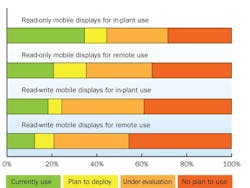Check out ControlGlobal.com on Google+ and Keith Larson's Google+ profile.
When push really comes to shove, what operators most need to succeed is access to the information they need, when they need it—and ideally nothing more. Process upsets and other crises draw these priorities in stark relief: raw data, alarms and other inputs must be transformed into actionable information in context in real-time—easily viewed, listened to, or otherwise sensed and interpreted in an integrated environment regardless of source.This includes traditional data, such as from the control system itself and secondary plant and business systems, as well as voice and video communication with field operators and other personnel. The challenge is to provide seamless access to these multiple sources of information, but at the same time not overload the operator with information that's irrelevant or data that's too granular.
ABB's approach to improving operator effectiveness through plant systems integration is based on the premise that an integrated operations environment, such as the company's System 800xA platform, must enable vertical, horizontal and functional information integration as well as seamless integration of collaboration and communication tools.
Vertical integration entails access to all information relevant to plant operation such as production orders, schedules and other business system information. Horizontal integration means access to information from other control systems and field devices, independent of vendor or vintage. Functional integration implies the availability of information from complementary plant systems not directly related to automation, such as for managing safety, power, maintenance, laboratory information and documents. And the ability to seamlessly integrate video, voice and other telecommunications systems directly into the unified operations environment provides an especially powerful tool for collaborative problem solving—while minimizing operator distraction.
Further, the ease with which these integration tasks can be accomplished depends to a large degree on a plant's choice of automation and information management architecture. The infrastructure should function as a seamless middleware, allowing the creation of ad hoc reports and decision-support mash-ups that combine individual pieces of information no matter where they may reside. ABB's System 800xA makes this possible because it's built from the ground up on an object-oriented architecture that effectively separates all the thousands of physical and logical entities that make up a plant from the information that describes them.
Integration Reduces Errors and Delays
When it comes to boosting operator effectiveness, the integration of information from complementary plant systems reduces the risk of manual data entry errors and delays. For example, the seamless flow of sales order information into raw material purchasing, production planning and process control systems means more accurate planning as well as improvements in process stability and production output. A delay of just one or two hours in reporting the quantities of ingredients consumed in one process step may mean that there isn't enough material for an upcoming batch. Handling these and other types of information in an integrated fashion means that all reporting is automatic, correct and instantaneous.
Process operators also require on-demand access to CAD drawings, user instructions and other plant documentation. During a process upset, a frantic search for a misplaced binder ranks high on the list of scenarios to be avoided. And once located, there's always the risk that the information is outdated and incorrect. Indeed, inability to access correct procedures or operating instructions has been cited as a contributing factor to a range of plant safety incidents.
But with the System 800xA's Aspect Object technology, calmly right-clicking a context menu immediately gives operators the correct documentation for the task at hand, such as instructions and drawings for a planned shutdown. A single version of the latest documentation is directly linked to the specific process object on the screen.
Integration Enables Team Collaboration
The direct integration of voice communication, public address and video systems in the ABB System 800xA environment enables more effective collaboration with other operators, field technicians, shift supervisors, maintenance staff and even offsite personnel—resulting in improved process stability, productivity and safety.
Live video, too, plays a key role in today's plant operations, and a modern facility may have hundreds of cameras in use simultaneously. With ABB's approach to integrated video, any live feed is available from within the operations environment. Video feeds can be embedded in process displays, and images shared with other individuals in the plant or on the outside.
Another benefit to the System 800xA's object-oriented architecture is that a relatively simple, browser-based thin client can be used to seamlessly retrieve and display everything that the operator sees, as well as ad hoc dashboard, trend and other reports. Displays are available inside or outside of the plant facility, as long as a secure connection to the plant network exists. Called the cpmPlus Smart Client, this application provides intelligent data access and viewing functions to assist all levels of personnel—including operators—in making quick, informed decisions to improve overall plant performance. Among the configurable dashboards that can be easily deployed are trending and statistical process control charts, alarm and event notifications, and even a Microsoft Excel interface for exporting plant data.
Power, Safety and Maintenance
While integration and collaboration's broad-ranging benefits carry into every corner of a process plant's performance, a closer look at the power of integration along three specific dimensions helps to illustrate integration's true potential to boost operator effectiveness, namely, in the integration of process automation with electrical power, process safety and maintenance management tasks.
As a leading supplier of energy infrastructure, ABB is uniquely positioned to bring power management, substation automation, process electrification and process automation together in one integrated system. Having one common operating interface improves visibility for electrical and process operators, streamlining plant-wide operation and generating savings in downtime, maintenance, energy and personnel costs.
Operators enjoy a complete view of plant energy loads and are able to effectively balance availability and consumption. Common event and alarm lists on a millisecond level simplify and speed up trouble-shooting and maintenance work, resulting in reduced disturbances and downtime. Other applications enabled include load-shedding; operators can safely—even automatically—trigger the shutdown of select processes in the case of a power supply shortage or to avoid a peak consumption penalty.
Improved visibility also allows the exploration of new energy saving opportunities and the enhancement of existing energy reduction programs. For example, an increase in power consumption by a unit or an area can indicate equipment malfunction or wear. In fact, the ARC Advisory Group has reported that simply increasing visibility into energy consumption can lead to as much as a 10% reduction in use.
Safety systems that are entirely separated from process control mean that operators often are left in the dark when a safety circuit alarm is triggered. System 800xA High Integrity provides an unprecedented level of integration with the operations environment, allowing operators to enjoy a familiar, all-in-one process overview with full visualization and common alarm lists that improve the understanding of process events and reduce risk. An integrated environment also can help to validate the accuracy and function of safety instrumentation against instrumentation used for process control.
Similarly, the ability of operators to easily submit fault reports from an embedded condition monitoring application to an integrated computerized maintenance management system (CMMS) speeds repairs, since maintenance staff receives more timely input about what corrective measures may be needed. Furthermore, since the equipment information is automatically filled in, manual errors are drastically reduced and much time is saved. The fault report is available for the maintenance department at the very same moment the operator presses submit, streamlining collaboration and improving the ability to address an anomaly before it affects production.








